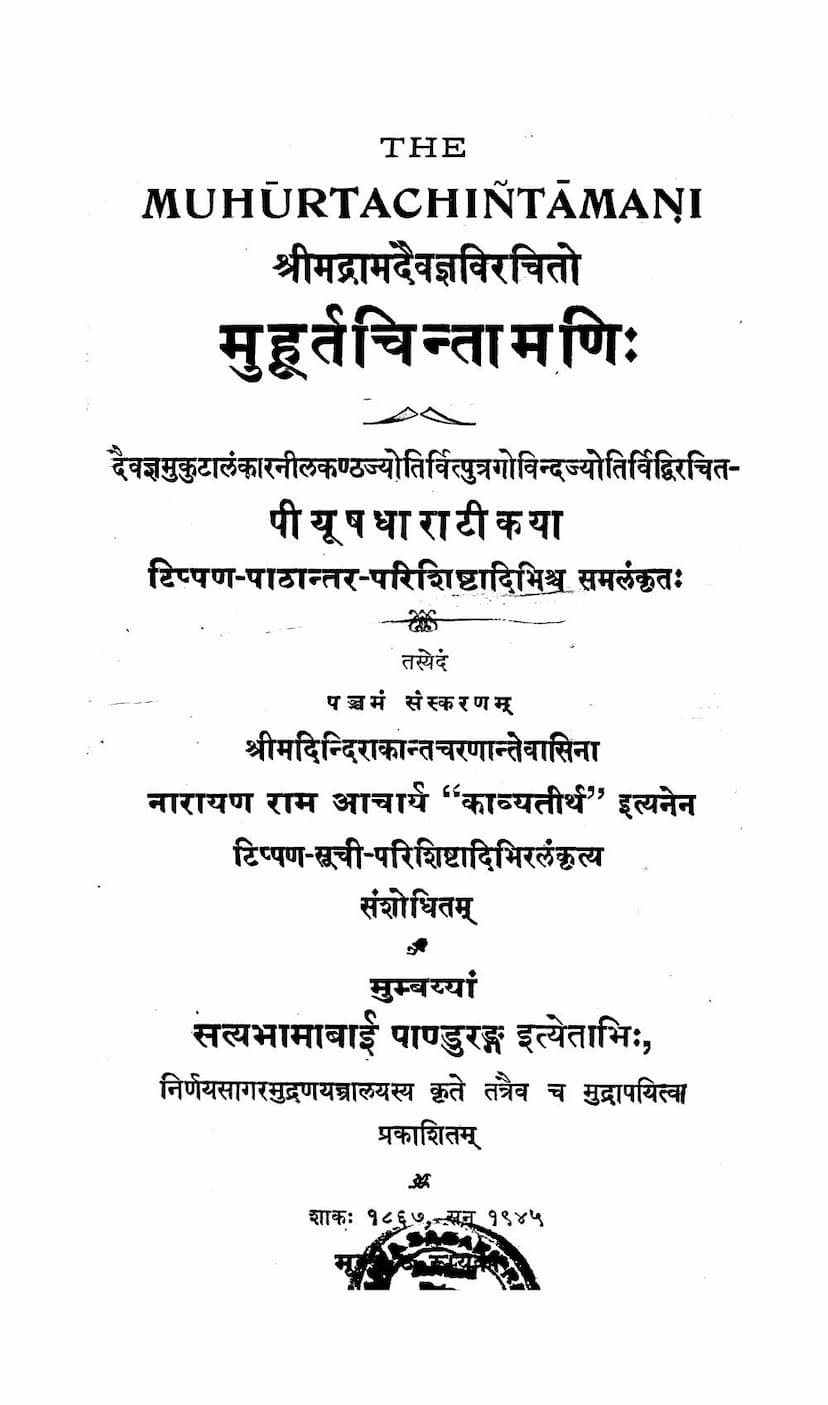Muhurt Chintamani
Added to library: September 2, 2025

Summary
"Muhurta Chintamani," authored by Narayanram Acharya and published by Nirnaysagar Press, is a comprehensive Jain text on muhurta (auspicious timings) in Hindu astrology. The book, translated and annotated with the "Piyushdhara" commentary, delves into various aspects of selecting auspicious times for significant life events and activities, drawing heavily from Vedic and astrological principles.
Key Themes and Contents:
The text is structured to guide the reader in understanding and applying astrological principles for various purposes. Based on the provided table of contents, the book covers a wide array of topics, including:
- Introduction to Astrology: The initial chapters likely introduce the importance and authority of astrology, citing scriptural references from Narada, the Vedas, and educational texts (Shiksha), emphasizing its role as the "eye of the Vedas" and its contribution to the correct execution of rituals (Shruta and Smarta karmas).
- General Astrological Principles: It discusses fundamental concepts like the nature of time, the influence of celestial bodies, auspicious and inauspicious events (Shubhashubha prakaran), and the significance of time divisions (Muhurta).
- Calendar and Time Calculations: The text explains the determination of months, including intercalary (Adhimasa) and omitted months (Kshaya masa), and the properties and effects of lunar days (Tithi), nakshatras (Nakshatra), and weekdays (Vara). It also covers aspects like lunar mansions' influence, yogas (Yoga), and specific planetary positions and movements.
- Auspicious Timings for Specific Events: A significant portion of the book is dedicated to identifying auspicious timings for:
- Life Cycle Rituals (Samskaras): This includes Garbhadhana (conception), Pumsavana (foetal virility), Simantonnayana (parting the hair), Jatakarma (post-natal rituals), Namakarana (naming ceremony), Annaprasana (first feeding), Chudakarma (tonsure), Upanayana (initiation), and Vivaha (marriage).
- Household and Construction: Auspicious times for digging wells (Kupa), ponds (Talaga), building houses (Griha), and performing consecrations (Pratishtha) are discussed.
- Travel and Journeys (Yatra): Guidance on selecting appropriate times for travel, considering directions, auspicious timings, and avoiding inauspicious influences.
- Specific Activities: The book also covers auspicious timings for activities like starting agriculture (Bijopati), harvesting (Dhanya Chheda), engaging in crafts and arts (Shilpa Vidya), engaging in trade (Vikraya Vipani), performing sacrifices (Homa Ahuti), and even specific actions like wearing new clothes (Vastra Paridhana).
- Dealing with Astrological Afflictions: The text addresses various astrological afflictions like malefic yogas (Dusta Yogas), combustion (Asta), eclipses (Graha), and specific doshas associated with planetary positions (e.g., Simhastha Guru). It likely suggests remedial measures or specific timings to mitigate these negative influences.
- Commentary and Annotations: The mention of the "Piyushdhara" commentary indicates that the text is not just the original verses but also includes detailed explanations, interpretations, cross-references, and potentially critical analysis.
Author and Publisher:
- Author: Narayanram Acharya is credited with revising and enhancing the fifth edition of this work, suggesting he is a significant editor or interpreter of this text. The original work is attributed to "Shrimad Ram Daivagya Virachita" and "Neelkantha Jyotirvit Putra Govinda Jyotirvid."
- Publisher: Nirnaysagar Press, Mumbai, is the publisher, indicating a reputable publication house in India. The publication date is noted as Shak 1867, which corresponds to 1945 CE.
Significance:
"Muhurta Chintamani" is a valuable resource for practitioners and students of Vedic astrology, particularly for those focused on selecting auspicious timings. Its comprehensive nature, covering a wide range of life events and activities, combined with the detailed commentary, makes it a significant work in the field of muhurta shastra. The text aims to ensure that important actions are performed at the most beneficial times, leading to successful outcomes and well-being.